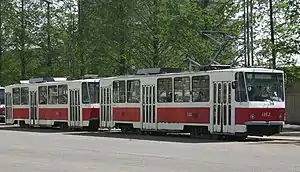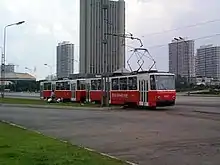Trams in Pyongyang
Pyongyang Tram is a public tram system in Pyongyang, the capital of the Democratic People's Republic of Korea (North Korea). The first line of the current system opened in 1989. There are currently four lines in operation.
 Older Tatra T6B5 vehicles on tram line 1 | |
| Overview | |
|---|---|
| Locale | |
| Transit type | Tram |
| Number of lines | 4 |
| Line number | 1, 2, 3, Kumsusan |
| Operation | |
| Began operation | 1989 |
| Operator(s) | Transport and Communication Commission |
| Character | At-grade |
| Train length | 2 car multiple unit, 3 section articulated tram |
| Technical | |
| System length | 53.5 km (33 mi) |
| Track gauge | 1,435 mm (4 ft 8 1⁄2 in) 1,000 mm (3 ft 3 3⁄8 in) |
| Electrification | Overhead DC 600 V, 20 A; up to 200 A during acceleration |
| Top speed | 60 kilometres per hour (37 mph) |
| Pyongyang Tram | |
| Chosŏn'gŭl | 평양 궤도전차 |
|---|---|
| Hancha | 平壤 軌道電車 |
| Revised Romanization | Pyeongyang gwedojeoncha |
| McCune–Reischauer | P'yŏngyang kwedojŏnch'a |


Overview
Before the Korean War from 1950 to 1953, there were three tramway systems in the entire Korean Peninsula: one each in Seoul, Busan and Pyongyang. However, the system in Pyongyang was discontinued after the war, largely due to the significant destruction of the city by US/UN bombing attacks. The remaining two in Seoul and Busan survived the war but were eventually discontinued too when motorcars became more common and a larger means of transport in South Korea in 1968, thus leaving no tramway networks on the peninsula.
Unlike South Korea, personal ownership of automobiles in North Korea is very rare. North Koreans, especially those living in Pyongyang and other major cities, rely mainly on government-run public transport. In Pyongyang, there are trolleybuses (the Pyongyang trolleybus system) and subways (the Pyongyang Metro), with these two serving as its main forms of public transport. However, as trolleybus lines became gradually overcrowded, the city decided to re-open tram-lines. The first line was built and opened in 1989.[1]
A number of Tatra T4 trams and its trailer B4 were bought from Dresden, Magdeburg and Leipzig in 1997-1998.[2]
In 2003, however, the section of Line 1 between P'yŏngyang-yŏk and Songyo was closed, as the bridge over Taedong River started to deteriorate,[3] splitting Line 1 into two parts divided by the Taedong River. The section from Songyo to Songsin was eventually replaced by a trolleybus in 2014. The part crossing the bridge was replaced by a bus service.
In 2008, the City Transportation Company of Prague sold 20 used T3s to Pyongyang Public Transportation Enterprise together with a shipment of tram-rails. These trams were made in the late 1970s and the early 1980s. According to Ondřej Pečený, a spokesman for the City Transportation Company of Prague, these trams are in very good condition, and can run for at least two years without the need of a service. The tram cars were made by Tatra, a Czechoslovak company, during that nation's socialist era. Various types are used, but there are currently no low-floor tram cars.
Foreign tourists were previously not permitted to ride the tram lines, but some recent tours have started to include tramway rides (though rides are not shared with locals and are instead chartered, unlike the Pyongyang Metro).[1][4]
Lines
There are currently three lines in operation plus a meter gauge line operated by the military.[5]
| Line Number | Route | Notes |
| #1[3] | Mangyongdae-guyok (만경대; 萬景臺) - Pyongyang station (평양역; 平壤驛) | Formerly ran to Songsin until bridge was closed to tram traffic, line split into Mangyongdae- Pyongyang Station and Songsin-Songyo until 2014, when during reconstruction of tram lines elsewhere, this line was converted to trolleybus line #4
Replaced former trolleybus line 10 from Mangyongdae to Chollima Street and 8 to Hwanggumbol station. Trams housed at Songsan Depot, Mangyongdae-guyok[6] |
| #2[7] | Munsu (문수; 紋繡) -
T'osŏng (토성; 土城) |
Runs on east side of Taedong River, replaced former trolleybus line 7.
Trams housed at depot at Munsu |
| #3[8] | West P'yŏngyang Station (서평양; 西平壤) -
Rangrang (락랑; 樂浪) |
Only line to currently cross the Taedong River
Trams housed at depot at Rangrang |
| Kumsusan | Samhung station
(삼흥역)- Kumsusan Palace of the Sun (금수산태양궁전) |
Operated when mausoleum opened to replace Kwangmyong station.
Operated by the military using meter gauge SWS Be 4/4 trams and SWS B trailers.[9] |
As of 2006, the fare is ₩5 for any section. There are also coupon tickets (시내 차표; 市內車票; sinae ch'ap'yo) issued in the form of tickets inserted into the fare box.[10]
Rolling stock
Prior to 2018, the rolling stock used were the Czechoslovakian ČKD Praha Tatra T6B5, Tatra T3, Tatra T4, Shenfeng KT4 and KT8D5K in either red/white livery or blue/white.[1] The Kŭmsusan line uses VBZ Be 4/4 Type Ib rolling stock on a different gauge of 1,000 mm, rather than 1,435 mm for lines 1-3.
For the full list, see Trams and trolleybuses in North Korea
In August 2018, following the introduction of new trolleybuses and metro cars, new partially domestically-produced tram cars were introduced in Pyongyang for the first time in about twenty years.[11] The bodies were manufactured by Pyongyang's Bus Repair Factory and named Tongil, on the chassis of the Tatra KT8D5K.[1]

See also
References
- "New tram cars appear on Pyongyang's Liberation Street line | NK News - North Korea News". NK News - North Korea News. 2018-07-31. Retrieved 2018-09-14.
- "Pyongyang, tramway — Roster". transphoto.org. Retrieved 2021-01-26.
- "平壌市軌道電車(路面電車)1号線". 2427junction.com. Retrieved 2020-07-20.
- "Public transport tours".
- "Pyongyang". transphoto.org. Retrieved 2021-01-26.
- "로동신문". rodong.rep.kp. Retrieved 2021-01-26.
- "平壌市軌道電車(路面電車)2号線". 2427junction.com. Retrieved 2021-01-26.
- "平壌市軌道電車(路面電車)3号線". 2427junction.com. Retrieved 2021-01-26.
- "Pyongyang, Kumsong Depot (1000 mm) — Roster". transphoto.org. Retrieved 2021-01-26.
- "平壌市軌道電車(路面電車)". 2427junction.com. Retrieved 2021-01-26.
- "개발창조형의 궤도전차 생산" [Domestic creation of tramcar production]. Sogwang (in Korean). 2018-08-14. Retrieved 2018-09-14.
Further reading
- Hayato Kokubu, Shōgun-sama no Tetsudō: Kitachōsen Tetsudō Jijō (将軍様の鉄道 北朝鮮鉄道事情; "Railway of the Dear Leader: The Railway Situation in North Korea"), 2007. (ISBN 4103037318)
External links
| Wikimedia Commons has media related to Trams in Pyongyang. |
